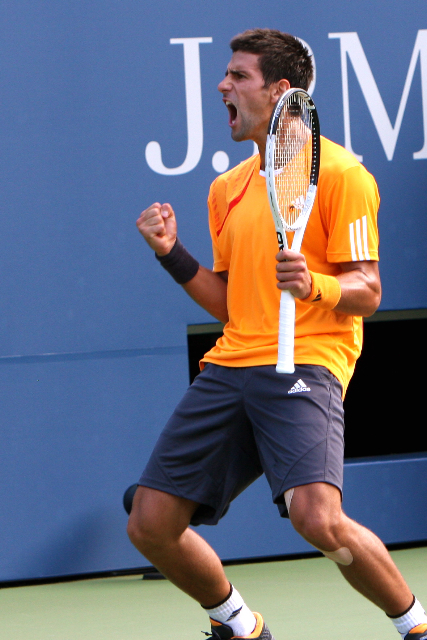Riding the Waves: Using Momentum to Win in Competition

A surfer sits out in the open ocean. The water is calm, the surfer is in complete control. Atop his surfboard, the surfer can enjoy the tranquility of his sport. However, he has not come out to the open water to enjoy tranquility. The surfer has ventured out in search of the big wave … the wave that will get his adrenaline pumping; the one that will satisfy his craving for the thrill of competition; the wave that will push him to the absolute limit. He has come not for relaxation, but to embrace a challenge. The surfer looks forward to the biggest wave that may come his way. When the “big one” comes along, it will undoubtedly test his physical abilities, challenge his mental game, and for a moment, leave the surfer wondering if he can come out of the wave unscathed. But if he does, if he stays on the board and is able to ride the wave out, he will be ready for whatever comes next. If he cannot stay on the board, he will spiral out of control, be thrashed under the water, and have no ability to take advantage of the calm seas which will follow or handle a new wave.
There are parallels between this anecdote and a tennis player competing in a match. Just like the surfer, a tennis player may begin a match in complete control. They make the shots they are supposed to make, and win the points they are supposed to win. But then, just as a wave is bound to occur in the open ocean, a change and momentum shift is bound to occur in a tennis match. This is the natural evolution of nature and sports. Consistency plays a small role in both. The wave is impossible to stop, the momentum cannot be controlled. The best strategy is to continue to battle and try to ride it out.
A surfer may see a wave approaching far in the distance, just as a tennis player senses a change in momentum before it shows on the scoreboard. The wave may show itself either as a letdown in one’s own game, i.e., unforced errors, double faults, etc. Or, a boost in your opponent’s game, i.e., aces, running winners, treeing, etc. Factors beyond the player’s control, such as poor line calls or distracting fan conduct, can also lead to a momentum swing. These situations are inevitable in a match. But given the player’s level of awareness to the specifics of a match and their ability to sense the upcoming waves of momentum, players have the opportunity to mentally hunker down and prepare themselves for the impending change. There are times when the waves may be so sudden that all the player can do is hang on, grind it out, and hope to stay afloat.
Metaphorically, the wave is a change of momentum often out of the player’s control. Your opponent may hit a winner that paints the line, or hit a ball that hits the net and trickles over for a winner. The only hope to get through the wave is to ride it out. The wave should not be viewed as a setback or even an obstacle, but rather, as an opportunity … an opportunity to test one’s ability to remain focused, level-headed and in control. An opportunity to adapt and adjust one’s game to what works best in changing situations, and an opportunity to push oneself both mentally and physically towards eventual success.
But success can only be achieved if a player can proactively ride out the wave and stay above water. The goal is to simply stay afloat … nothing fancy, just keep grinding. Countless times, Rafael Nadal has demonstrated his ability to do this by saving break point after break point in a match. Just as the calm existed before the wave, the calm will resume after the wave has passed. The question becomes: Is the player still on the board, or have they let that wave throw them off? If they are on the board, they are in a position to battle once the wave and momentum passes. However, if the player feels sorry for themselves, cannot stop thinking about past points, and is despondent about the negative turn of events, they will be completely unaware that the wave has passed. They will continue to spiral out of control. The player will not be able to take advantage of the newly-found calm after the storm.
A player must recognize that momentum shifts are unavoidable in competition. It is just part of the rhythm of a match. Just as waves in the ocean ebb and flow, the course of a match constantly changes as well. This is a natural phenomenon and the reason why we find sports so entertaining. Waves, momentum shifts and adversity in a match should be seen as a challenge, something to be embraced. Perhaps Billie Jean King said it best when she texted Maria Sharapova “pressure is a privilege.” before Sharapova beat Serena Williams in the 2004 Wimbledon finals.
In the end, riding the big wave is the ultimate thrill. A surfer may struggle with the wave, but stay on the board and ride the big wave out. Or, they may completely fall off the board and capsize. When the surfer stays consistent and sensible, calm under pressure, that surfer has a chance to persevere no matter how big and how many waves come his way. A surfer, once he knows he can handle the waves, embraces even bigger waves, hopes for even bigger challenges. Only through challenging oneself and confronting increasingly bigger obstacles can you improve. No one’s saying the wave will be easy to ride out, the object is to battle it and stay afloat. Only by embracing the challenge of a big wave and testing one’s limits will true potential be uncovered. Remember, nothing great is ever achieved without overcoming adversity.






